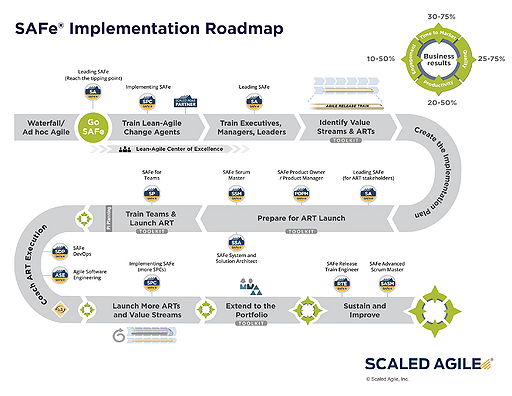SAFe
Developed by Anna Shevchenko
Agile methods of project management are becoming increasingly popular even outside their origins as methods to organize software development teams. While these methods cover the project management aspect, they do not provide guidance as to how to manage programs as a whole, and due to the particularities of agile project management, special methods of program management have been developed to handle project teams using an agile methodology. SAFe is one such method of Program Management focusing on synchronizing agile project teams while also following Lean principles ie. trying to deliver a maximum of value to the customer in the shortest sustainable lead time.
This article's purpose is to explain the SAFe methodology, its concept and its application in order to manage Programs composed of projects following Agile methods.
The SAFe method is articulated around four core values[1]:
- Alignment of management and teams to a common mission,
- Built-in quality practices,
- Transparency,
- Program execution.
In order to pursue these values, SAFe organizes teams in stable teams of teams in the form of one or several Agile Release Train (ART). An ART is a networked organizational structure which relies on decentralized decision making for faster response times and higher reactivity.
SAFe is designed for scalability and is capable of supporting smaller scale programs involving less than a hundred team members as well as complex programs involving thousands of people. It is available in four different configurations depending on the needs of the user[1]:
- Essential SAFe the basic version of SAFe upon which the other configurations build on;
- Portfolio SAFe to apply the SAFe methodology to Portfolio Management;
- Large Solution SAFe for complex solutions that involve multiple ARTs but do not need to consider Portfolio management;
- Full SAFe that is meant to apply the SAFe methodology at every level.
Contents |
Concept
SAFe Principles
SAFe is based on nine main principles[2] :
- Take an economic view
The main aim of SAFe is to make it possible for a company to deliver as much value as possible in the shortest sustainable lead time. SAFe achieves this through incremental value delivery and decentralized decision-making, which requires the creation of a strategy and an economic framework in the light of which decisions can be taken.
- Apply systems thinking
In order to fix problems, it is necessary to understand complex systems, which consist of multiples components related to each other. Focusing on one component of the system won’t make it possible to optimize the entire system. Moreover, it is important to be aware of the main goal of the system and to be committed to this goal. In order to apply SAFe, it is required to think of the system as a whole and not only of the organization which builds the system, but also to the systems under development.
- Assume variability; preserve options
SAFe follows a different approach for choosing design and life cycle practices from most practices. It keeps multiple design options and requirements for long time. SAFe uses empirical data to choose the right design and avoid excessively time consuming adjustments and suboptimal long-term design, which can result of a wrong design choice in early stages.
- Build incrementally with fast, integrated learning cycles
- Base milestones on objective evaluation of working systems
- Visualize and limit WIP, reduce batch sizes, and manage queue lengths
- Apply cadence, synchronize with cross-domain planning
- Unlock the intrinsic motivation of knowledge workers
Researchers proved that in order to achieve a high level of employee engagement it was needed to show purpose and give autonomy, and to put constraints at a minimum level. At the same time, individual incentive compensation will lead to internal competition and decrease cooperation, which will lead to longer times to achieve the goals of the system and will put both customers and the enterprise in an unfavorable position.
- Decentralize decision-making
The Essential SAFe
Implementation
The implementation of SAFe is done in three main phases:
- A preparation and planning phase
- A minimum application phase
- An expansion phase
During the first phase, key staff such as managers, leaders and change agents are trained in the SAFe method. ARTs and value streams are identified, and an implementation plan is created. Once this first phase is completed, the second phase starts by preparing for the ART launch and training the teams themselves in the SAFe method, then the first PI planning is organized and the ART is launched. A coaching in the SAFe ways is organized around that first ART, first focusing on the basics of SAFe but going deeper and deeper as the teams become more proficient. Once this first ART has been launched and a coaching team is organized around it, the third phase starts where SAFe is generalized and applied to more aspects of the company: more value streams and ARTs are launched, the method is extended to Portfolio management and the company globally tries to sustain and improve its processes.
Limitations
SAFe's limitations pertain mainly to two categories. The first one is that it necessitates a lot of investment in training and coaching, or in the hiring of consultants in order to start applying it[3]. The second one is that it takes away a lot of power from the individual teams in favor of a more centralized approach, which goes against the values of agile methodologies[3]
- Heavy training required
- Less initiative left to the team members, less decision making occurs at the team level contrary to Agile principles
- Longer planning cycles than other methodologies based on Agile principles
- Requires relatively heavy administration, oversight and leadership layers
Bibliography
SAFe® 4.5 Introduction: Overview of the Scaled Agile Framework® for Lean Enterprises, Scaled Agile, Inc., August 2017
